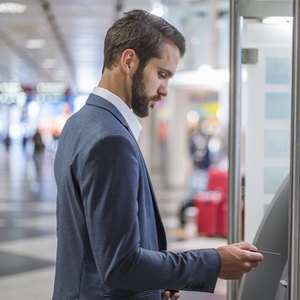
ATM debit cards are a huge convenience, especially compared to the days when people had to visit their bank branch to get cash or make a deposit. Unlike a credit card, debit cards help control spending since you can access only the amount of money you have in your bank account. But as with many things in our modern world, ATM cards bring a certain amount of risk along with great convenience. Although an ATM card might seem a lot like a credit card, there are circumstances when it makes more sense to use one or the other.
Lost or Stolen ATM Card
One of the main differences between an ATM card and credit card is the way fraud is handled. When you use an ATM card, money is immediately deducted from your bank account. Under federal law, you have two business days to notify your bank or credit union after your card is lost or stolen. Even then, you could be responsible for up to $50 in unauthorized transactions. If you wait for more than 60 days to report fraudulent withdrawals, you could be liable for up to $500. In contrast, you would be responsible for no more than $50 for unauthorized charges made with a lost or stolen credit card, and many card issuers absorb that amount.
ATM Card Fraud
One of the most prevalent causes of ATM card fraud involves sabotage of ATM machines. According to the FDIC, criminals use high-tech devices to steal card information and record keystrokes as customers enter their PIN numbers. The same types of devices have been used on card readers in gas stations and convenience stores. Criminals also use hidden cameras to record PIN entry. Consumers should be on the lookout for plastic devices that have been fitted over the slot where a card is inserted into an ATM machine. To avoid fraud, don’t use an ATM that appears it has been tampered with and regularly check your bank account statements for unauthorized withdrawals.
Hidden ATM Fees
You can be charged every time you use your ATM card unless you know which ATM machines you can use for free. Depending on the type of ATM card you have, you might be limited to using it for cash withdrawals only at branches of your bank or credit union. Many cards can be used free of charge within a network of financial institutions. Find out where you can use your card for free to avoid withdrawal fees. If your card can only be used at a limited number of locations, you might want to consider switching to a different bank.
No Purchase Protection
Many credit cards offer purchase protection as a benefit to attract customers. This protection means you could be refunded for purchases that are damaged or lost and you might even be able to get refunds on purchases that a seller refuses to refund. None of these protections are available with your average ATM card; using one of these cards is just like using cash or writing a check, with the bank typically providing no additional purchase protection.
References
Writer Bio
Catie Watson spent three decades in the corporate world before becoming a freelance writer. She has an English degree from UC Berkeley and specializes in topics related to personal finance, careers and business.
